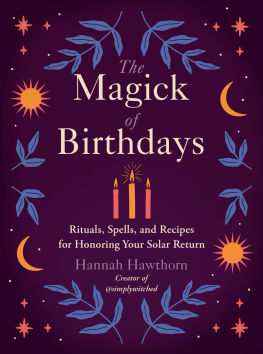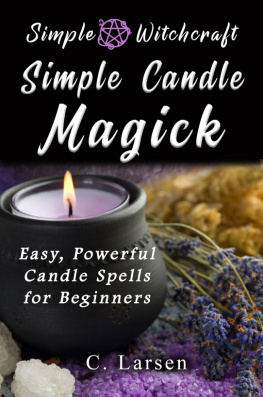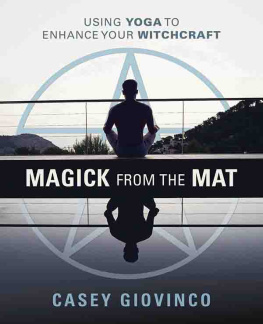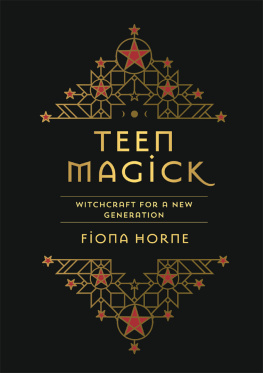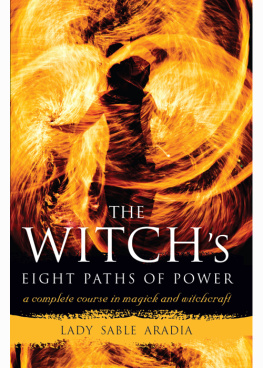Anjou Kiernan - The Ultimate Guide to Witchcraft: A Modern-Day Guide to Making Magick
Here you can read online Anjou Kiernan - The Ultimate Guide to Witchcraft: A Modern-Day Guide to Making Magick full text of the book (entire story) in english for free. Download pdf and epub, get meaning, cover and reviews about this ebook. year: 2020, publisher: Fair Winds Press, genre: Religion. Description of the work, (preface) as well as reviews are available. Best literature library LitArk.com created for fans of good reading and offers a wide selection of genres:
Romance novel
Science fiction
Adventure
Detective
Science
History
Home and family
Prose
Art
Politics
Computer
Non-fiction
Religion
Business
Children
Humor
Choose a favorite category and find really read worthwhile books. Enjoy immersion in the world of imagination, feel the emotions of the characters or learn something new for yourself, make an fascinating discovery.

- Book:The Ultimate Guide to Witchcraft: A Modern-Day Guide to Making Magick
- Author:
- Publisher:Fair Winds Press
- Genre:
- Year:2020
- Rating:4 / 5
- Favourites:Add to favourites
- Your mark:
- 80
- 1
- 2
- 3
- 4
- 5
The Ultimate Guide to Witchcraft: A Modern-Day Guide to Making Magick: summary, description and annotation
We offer to read an annotation, description, summary or preface (depends on what the author of the book "The Ultimate Guide to Witchcraft: A Modern-Day Guide to Making Magick" wrote himself). If you haven't found the necessary information about the book — write in the comments, we will try to find it.
Anjou Kiernan: author's other books
Who wrote The Ultimate Guide to Witchcraft: A Modern-Day Guide to Making Magick? Find out the surname, the name of the author of the book and a list of all author's works by series.
The Ultimate Guide to Witchcraft: A Modern-Day Guide to Making Magick — read online for free the complete book (whole text) full work
Below is the text of the book, divided by pages. System saving the place of the last page read, allows you to conveniently read the book "The Ultimate Guide to Witchcraft: A Modern-Day Guide to Making Magick" online for free, without having to search again every time where you left off. Put a bookmark, and you can go to the page where you finished reading at any time.
Font size:
Interval:
Bookmark:
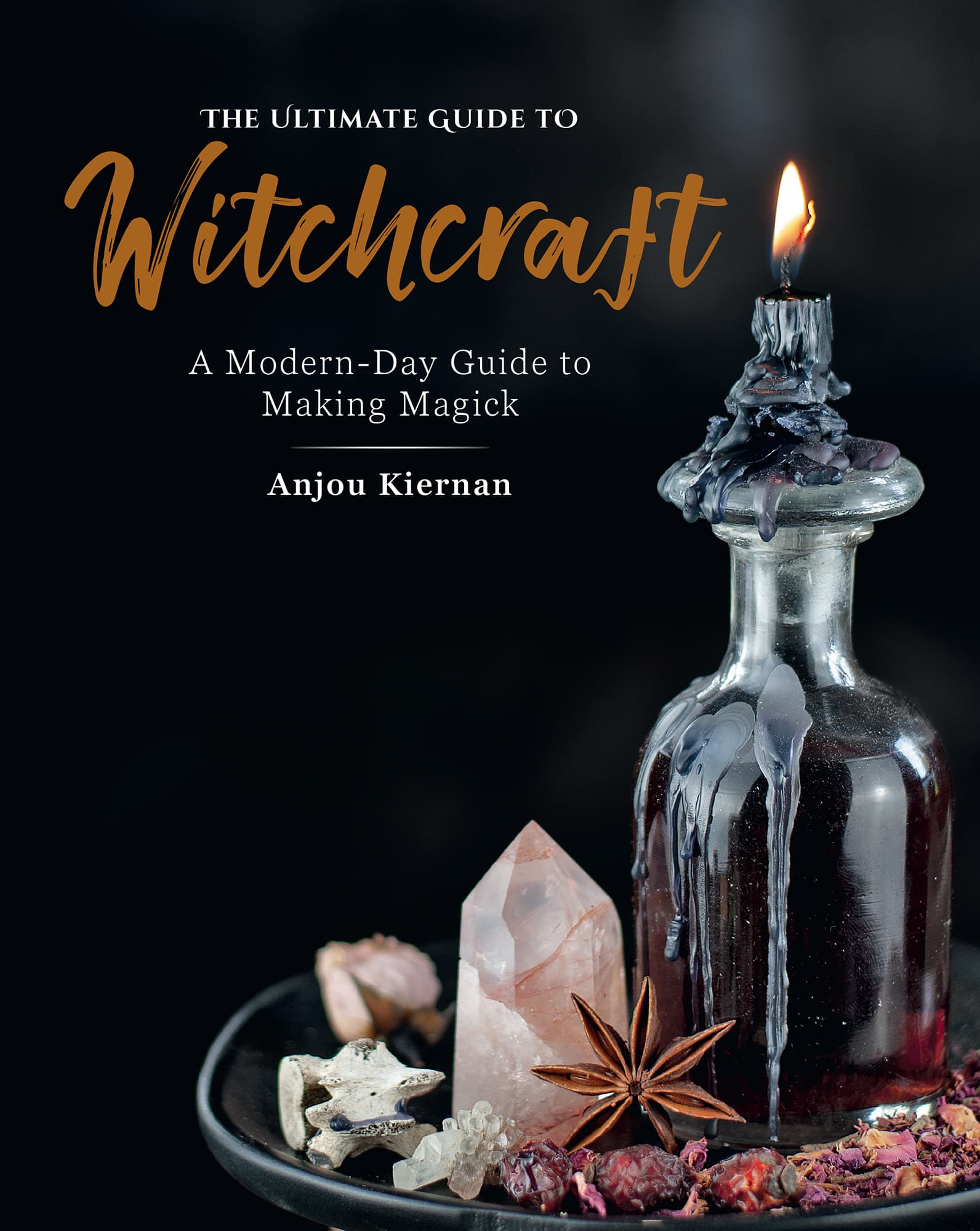
A Modern-Day Guide to Making Magick

Anjou Kiernan


Witchcraft is the belief that the universe weaves an indescribable magick through the stars. It is the knowledge that the linear thought processes of human consciousness are but one facet of our existence. By its very definition, witchcraft is not meant to be confining or rigid, stagnant or stale. It is meant to encompass the vastness of our experience, including that which we have yet to understand.
Witchcraft listens to the groaning of the trees, the howling of the winds, and the whispers of spirits across the veil. It changes and grows with our needs and the needs of the world around us. In its very essence, witchcraft is the relationship that we cultivate with the unseen forces of nature. This book will help you develop your own relationship with the magickal forces that abound by guiding you through a modern approach to natural witchcraft that is based on ancient practices. From harnessing the power of the Moon to seeking answers from beyond, it will empower you to create your own personal brand of magick that resonates with the universe.

In the beginning, there was only witchcraft. Tens of thousands of years before recorded history began, hunter-gatherers performed rituals under skies twinkling with mystery. The Lascaux cave paintings from the Paleolithic period, created by artists who were under the influence of trance dances, depict shamans, hunting rituals, and animal figures. Mother goddess figurines and a horned godfigures prevalent in Wicca and other duotheistic neopagan religionsappeared, alongside evidence of ceremonial burials, cremations, and ritual artifacts.
As these prehistoric societies evolved, they formed cults and made sacrifices in conjunction with Sun and Moon magick. Thought to represent the birth of pre-Christian religion in old Europe, these cults are the basis for many modern witchcraft-centered religions. While the term witch did not appear until much later in the Old Testament (1 Samuel), early humans certainly practiced what we would consider today to be witchcraft. Witchcrafts evolution, like much of human history, was shaped by the ebb and flow of cultures throughout the various regions of the world. You will find elements of Hinduism, Christianity, and other ancient religions in modern pagan practices, and vice versa, as a result of invasions, trade routes, and even documentation of witch trials. Though pagan practices have historically been suppressed by patrifocal monotheism, resurgent beliefs in the old ways and the neopagan revival have, in many ways, opened the doors for the reclamation of ancient pagan practices, and have helped to incorporate them into the modern practice.

One of the prevailing misconceptions about modern witchcraft is that to call yourself a witch, you must be Wiccan. Wicca is actually a contemporary pagan religion developed by retired British civil servant Gerald Brosseau Gardner in 1954, and it derives many of its tenets and rituals from global pre-Christian paganism. Although Gardner referred to it only as Witchcraft (or the Craft) in his writings, it was dubbed Wicca after it began to spread from England to North America.
Both then and now there has been much controversy surrounding Gardner, particularly regarding his fixation on ritual sex and nudism and an increasing focus on the God over the Goddess. Many traditions split off from this original form of Gardnerian Wicca, and most of them adapted or transformed the basic tenets that Gardner set forth into forms of Wicca that were based around a particular ancient culture or around a matriarchal focus.
While Wicca and its traditions are immeasurable in their value to the witching community, it is possible to incorporate the same magickal practices and elements that originated in pre-Christian paganism into our own practice without subscribing to any witchcraft-based religion. This is what is known as secular witchcraft. By simply focusing on creating magick with the natural world, we can open our practice beyond the limitations of religion.
Thankfully, witchcraft has continued to dissociate itself from the negative connotations that have plagued it in the past. Nowadays many people who adhere to mainstream religions also identify as witches. After all, there is no rule stating that a witch must refute the supreme beings that belong to Christianity and other theistic religions. When it comes down to it, witchcraft and theistic religions share the same core beliefthat there are supernatural forces at work in the world and that cultivating a relationship with them is the underlying purpose of our existence. Once we understand this, it becomes clear that witchcraft can peacefully coexist alongside organized religion.
Like most concepts in this book, whether or not to make a distinction between the words magic and magick is a choice that every witch can make for themselves. While magic has been associated with everything from ancient shamanistic journeys to pulling rabbits out of hats, magick has been used only in the practice of occultism.
Thought to have first been publicized in the sixteenth century by Heinrich Cornelius Agrippa in his Three Books of Occult Philosophy, and later by Aleister Crowley, a Victorian occultist who was the main influence for Gardnerian Wicca, the term magick has come to represent the kind of modern craft practiced with an authentic belief in the ability to transform natural laws. So, with the increasing popularization of witchcraft, many witches have felt the need to reclaim the true practice of occultism and have chosen to adopt the altered spelling as a result. Because this guide leads you on a ritual-based path through natural witchcraft, we also use the term magick in the pages that follow. That said, you do not have to earn the right to participate in, or be born into, magick. It is not the one true path, nor is it exclusive. It is simply there to claim if you choose it.
FAMOUS GRIMOIRES IN HISTORY

The Sworn Book of Honorius is thought to be one of the oldest medieval grimoires, appearing in manuscripts since the thirteenth century. Its ninety-three chapters detail necromancy and magickal operations as well as unique rituals for finding treasure or catching thieves. It is said to have been compiled from an ancient magicians conference that sought to preserve magick in the face of persecution.
Font size:
Interval:
Bookmark:
Similar books «The Ultimate Guide to Witchcraft: A Modern-Day Guide to Making Magick»
Look at similar books to The Ultimate Guide to Witchcraft: A Modern-Day Guide to Making Magick. We have selected literature similar in name and meaning in the hope of providing readers with more options to find new, interesting, not yet read works.
Discussion, reviews of the book The Ultimate Guide to Witchcraft: A Modern-Day Guide to Making Magick and just readers' own opinions. Leave your comments, write what you think about the work, its meaning or the main characters. Specify what exactly you liked and what you didn't like, and why you think so.

